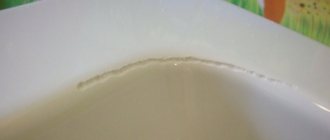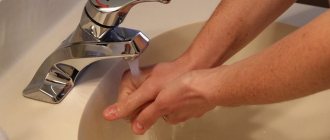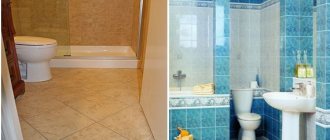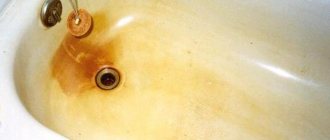The rapid increase in water tariffs is increasingly forcing consumers to think about how many liters are in a standard bath. After all, it is the adoption of water procedures that is one of the main items of water consumption in the apartment.
To learn how to use water rationally and at the same time reduce financial costs, you should clarify how many cubic meters are in a standard bathtub, and how you can moderate your “appetites” for water consumption.
A bath consumes a huge amount of liquid, since a person needs significantly less water for other needs. On average, one family spends no more than 25 liters a day on cooking, about 40 liters on brushing teeth and washing, about 110 liters on taking a shower, but large volumes of liquid are spent on soaking in the font.
How many liters are in the bath?
Now we know that daily water costs are quite high and we are trying to save. To this end, many people wonder how many liters are in bathtubs made of different materials - cast iron, acrylic, steel?
Naturally, the material from which the bathtub is made does not affect its volume. The main thing here is to understand whether you are bathing in a bath or just relaxing in warm water.
The table shows the sizes of different baths and the volume of water in liters.
| Baths, model | Dimensions, cm | Volume, l |
| "Neptune" | 175x70 | 169 |
| "Siberia" | 170x175 | 245 |
| "Languor" | 150x70 | 153 |
| “Nakhodka” | 170x75 | 210 |
How to reduce water consumption?
If you are under 180 cm tall, you can save 20 liters of water daily simply by choosing a bowl that is 10 cm shorter (170 cm). A 150 cm long sitz bath will not help you save money, because its volume is 290 liters.
A lot depends on the design of the shower head. Sometimes it is enough to change the nozzle and you will get a better distribution of water flows throughout your body. You will get no less pleasure, and the bills will be more pleasant for your wallet.
Standard bath
Question: how much water does a regular bath hold? Due to the different sizes of bathtubs, it is difficult to say for sure. How many baths - so many options. A standard bathtub holds approximately 200 liters. But the hydromassage baths can accommodate several people. Bathtubs of this type can hold from 600 to 900 liters! Without performing complex mathematical calculations, a noticeable difference is visible.
For those who are especially persistent and curious, data on the capacity of standard-sized hot tubs:
- a bathtub 150x75 cm holds 160 - 180 liters;
- bath 170x70 cm approximately 190 - 220 l.
Dimensions of a standard bath
It is clear that two parameters are not enough to accurately know the volume of the bath. Height must be included in the calculations. But, as a rule, not all manufacturers are in a hurry to publish sizes.
Of course, you can see the necessary numbers, if you look hard enough, from all manufacturers. This is not a task within the scope of this article. The main thing to remember is that consumption does not depend on the volume of the bath, but on how water procedures are taken. Statistics show that the average person spends 250 liters. Sometimes it exceeds 700 liters.
Standard bath volume 1.7 m and 1.5 m in liters
In plumbing stores, where most people shop, you often find standard-sized bathtubs in the shape of an elongated bowl with a slight slope at the back and sides at the top. The outer edge of the sides forms a rectangle (for ease of installation in a corner or along a wall). It is precisely these rather cumbersome plumbing structures that are present in 90% (no less) of the apartments of our compatriots.
According to metrologists, the volume of such a cast iron bath, 1.5 m long and 0.4 m deep, ranges from 140 to 170 liters, depending on its width. If the length is 1.7 m, it can hold from 180 to 245 liters of water.
In old housing stock, sometimes there are “sitz” baths of 1-1.2 m. Their volume is 95-100 liters.
Attention! Length and width in this case mean the distance between the two outer opposite edges.
How many liters does it take to take a bath?
We talked about a regular bath. The person just lies there for a few minutes and relaxes. Then I washed off everything unnecessary, rinsed in the shower and that’s it. In this case, the volume of water will be within 200 liters.
What if you take a bath for relaxation? With rich foam, with various salts, oils and flavors? The beneficial effects are believed to be as follows:
- a bath with soda protects the skin from dryness;
- with table salt – has a general strengthening effect on the body;
- with sea salt – helps reduce fatigue and joint pain, improve the overall condition of the skin;
- with pine needle extract – eliminates allergic redness and has a calming effect on the nervous system;
- with sedge - for those who have urolithiasis problems;
- with honey helps to relax and improve sleep;
- with a mixture of powdered milk – makes the skin elastic;
- with a glass of fruit vinegar - eliminates flaking of the skin.
Here you cannot do without the gradual adoption of water procedures.
- 150 – 200 liters for relaxation;
- 100 - 200 liters to wash away dirt;
- 40 – 50 finally rinse in the shower.
Thus, fluid consumption increases significantly.
Specifications
The volume of a bathtub of 150 cm in liters, as well as 170 cm (also a popular standard size), is determined based on their standard dimensions. If we talk specifically about standard domestic bathtubs (imported ones may differ slightly), then they have dimensions typical for Soviet-built houses:
- length: from 150 to 170 cm (1500-1700, less often 1800 mm);
- width: from 70 to 75 cm (700-750, less often 650 mm);
- depth: from 40 to 50 cm (400-500 mm);
- angle of inclination of the sides: from 50 to 80˚.
Remember! When making calculations, it is necessary to take into account that 1 liter in volume corresponds to 1 cubic decimeter.
Baby bath
If we talk about the volume of a children's bathroom, they are also of different sizes. Bathtubs are different, as are manufacturers.
| Baths, model | Dimensions, cm | Volume, l |
| Prima Baby Dolphin | 84x49x30 | 25 |
| Neonato Surf | 96x54x19 | 25 |
| Hoppop Bato+ | 40x75x28 | 25 |
| Combi 19975 | 52.6x80x26 | 35 |
But, the child is bathed in the bathtub in several stages. Various additives, such as chamomile, can also be used here. This means that the volume of water consumed also increases. But of course, adults spend much more water on themselves. If you compare all the examples given, you can understand that the main water consumption depends on the person himself.
We determine the sizes of various shapes and types of bathtubs
The displacement of each bathtub is determined primarily by its internal shape . Now there are many different models on the plumbing market. We've sorted out the rectangular bathtub, let's consider other options.
Rectangular with beveled sides
The volume of such a bath is calculated using the formula for a truncated pyramid (only in our case it is inverted):
V = 1/3H×((L1×B1+ L2×B2+√¯(L1×B1×L2×B2)),
where H is the height, L1 and B1 are the length and width of the bottom, L2 and B2 are the length and width of the water surface, √‾ is the square root.
Round
Calculate the volume of half the ball:
V = (4/3×π×R3):2,
where R is half the diameter of the inner surface at water level. The calculation will be almost ideal if this value coincides with the depth.
Oval
If the bath is in the shape of half an ellipsoid (a ball, flattened from the sides and elongated in length), we use the expression:
V = (4/3×π×½L×½B×H):2
π=3.14, ½L, ½B and H, respectively, half the length, half the width and height. If the last two indicators are equal, the result will be more plausible.
If the bottom is not sloping, but flat, calculate the volume of a cylinder with an oval base:
V = π×½L×½B×H,
using the same measurements as in the previous case.
Corner
We will assume that its shape is similar to a quarter of an ordinary or elliptical cylinder.
For the symmetrical option:
V = (π×R2×H):4,
where R is the length of one of the internal walls coming from the corner of the bathroom (they are the same), and H is the depth.
For an asymmetrical model:
V = (π×L×B×H):4,
where L is the length of the larger wall, B is the smaller wall, H is the depth.
Custom baths
These include specimens that have bevels on one side or bizarre curves. The biggest difficulty arises with measuring just such baths. Their forms can sometimes be “divided” (conditionally, of course) into two or more components from regular geometric shapes, then you will have to create a complex combination of various formulas . Puzzle lovers can try it (nothing is impossible for a person with intelligence). However, I recommend returning to the first measurement method using meter readings.
Baby bath
As a rule, it resembles a standard rectangular or oval. You can use the formulas given above, but it is much easier to establish the truth experimentally. The volume of this container usually does not exceed 35 liters . It is recommended to bathe newborns in boiled water and at first there is no need to fill the bath to the brim. So prepare 2-3 5 liter containers in advance, boil the rest immediately before bathing and determine what capacity is needed for bathing your baby.
Calculations for bath volume
The most inquisitive ones can try to determine the volume by simply pouring buckets of water into the bathtub. This may be an interesting and exciting process for an inquisitive mind and to find out how much water the container will hold, but it takes a lot of time and effort, it is so labor-intensive. The method is also suitable for those who already have a bathtub at home.
What if you choose new plumbing? This method is clearly unacceptable. The volume of the bath can be calculated if you know the parameters of the product. This way you can find out how many liters the bathtub you like holds.
How to measure the volume of your bathtub?
The capacity is usually specified in the documentation that comes with the product upon purchase.
By the way! The passport usually indicates the filling capacity up to the overflow line.
If the document is lost (let’s say the plumbing is 10 years old or more), and you want to independently determine the volume of your bathtub, there are three options for how to do this.
If you have water meters, use the easiest method . Before the next water procedure, record their exact readings on paper (including all black and red numbers), then fill the bath. After this, write down the new data and calculate the difference. This method is good because it does not depend on the shape of the bathtub and is suitable for any model , and the calculation itself is simple and will not take much time - exactly as long as the water is drawn, plus 2-3 minutes to solve a simple example.
By the way. In the absence of meters, payment is made according to standards, and they do not depend on the actual amount of resource consumption, so you can pour water calmly.
If you want to train your brain, try the second method. It will require the following actions:
- first of all, figure out what geometric figure the inner surface of your bathtub resembles (school knowledge of stereometry for grades 10–11 will come in handy);
- remember the formulas for the volume of a parallelepiped, sphere, ellipsoid, cylinder, truncated pyramid, etc.;
- take the necessary measurements and make calculations.
With this method of calculation, errors are inevitable, since only a few bowls can “boast” of an ideal geometric shape.
If you want to get the most reliable information about the displacement of the bathtub, stock up on a canister (a 5-liter bottle will do) and patience. Of course, you will spend a lot of physical strength, but your soul will be calm.
Calculation example
Let's consider a simple option . Let us denote the initial readings of the cold and hot water meters as a and b, and the final readings as a1 and b1. To calculate how many liters of water was used, use the template:
((a1+b1) — (a+b))
Experiment in my bathroom:
a = 337960, b = 77750, a1 = 338100, b1 = 77840;
V = ((338100+77840) - (337960+77750)) = 230 l.
Difficult option . I have a standard cast iron bathtub 170x70x40. Its internal shape can be called conditionally a parallelepiped (more simply, rectangular).
I measure the required values (at the level of the overflow line, in cm):
- L(length) = 150;
- B(width) = 55;
- H (height) = 30.
I plug my numbers into the formula:
V = L×B×H= 150×55×30 = 247.5 l.
It turned out to be more than in previous calculations. This is understandable; the narrowing and rounding of the surface downwards, on the sides and the bevel of one of the walls was not taken into account . Hence the extra liters.
Approximate calculation
Let's calculate the volume of the container with these parameters (in centimeters):
- length 155;
- width 70;
- height 55.
Knowing that a liter is one cubic decimeter (1 l = 10x10x10 cm), we convert the dimensions into decimeters. Then we multiply these same parameters (in decimeters).
15.5x7x5.5 = 596.75
We round the resulting value and get a volume of 597 cubic decimeters or liters.
Using this example, you can also make calculations for other types of bathtubs. But when making calculations, we must remember that the height of the bathtub is taken without taking into account the height of the legs or frame under the bathtub. By purchasing a new bathtub and knowing its output data (you can measure it yourself), the volume of the product can be calculated easily.
Conclusion
The volume of a standard bathroom is quite easy to find out. For some people, the figures on water consumption for necessary procedures may be shocking. But if you are serious about starting to save, be sure to read the data sheet of the model you like before purchasing a hot tub. This is especially true for asymmetrically shaped devices, the volume of which is very difficult to determine independently.
The document must indicate all the parameters of the font and its volume. As a result of familiarizing yourself with this data, it will be much easier for you to control your water consumption, which means that the utility bill will not be an unpleasant surprise for you.
Volume of bathtubs of non-standard shape
Now you understand the algorithm for calculating the volume of containers of any size, but rectangular. What if the bathtub is oval or round? Knowledge of the basics of mathematics also comes to the rescue here. But does this use the value ? = 3.14.
So if one side of the bowl is 55 centimeters long and the other 65 centimeters with a height of 44 cm, the area will be equal to 3.14 x 55 x 65 = 11,225 cm?.
The resulting value for the area of the bathroom must be multiplied by its depth 11,225 x 44 = 493,922 cm?. We get 493,922 cm?. This means our bathtub has a volume of 494 liters. A bathtub of this configuration can hold so much water to the brim. Everything is simple and you don’t have to run around with buckets to find out the volume.
Remember or write down these formulas, and choosing a bath of any size will be much easier. Conscientious manufacturers describe all the necessary information in the product passport. And it is right. Without knowing the overall dimensions of bathtubs, it is difficult to choose a product for your room.
When purchasing products for a bathroom or toilet, do not hesitate to find out detailed information from sales consultants. It is for these purposes that they work with you. Knowing the volume of the bathtub in advance, you can prevent unnecessary expenses on paying for water consumption and save on your budget.
Volume of standard “Soviet” models
In earlier times, basic GOSTs were developed that regulated the dimensions of plumbing fixtures. At the same time, models of four main standard sizes were produced for apartments and the private sector.
The main difference was the length and height. The width varied from 65 to 75 m in 5 cm increments.
Sedentary:
“Mini” - 120x60 cm, volume 210 l.
"Midi" - 150x50 cm, volume 290 l.
This is an excellent option for the private sector, where the design did not include a bathroom at the time. For such a small bath, a place can be found in the kitchen, on the veranda or in a small extension.
Also, sitting models have become a lifeline for residents of hotels and former hostels. In apartments like these, every centimeter counts. Compact but capacious bowls make it possible to warm up well on a winter evening and refresh yourself on a summer day.
Recumbent:
“Comfort” - 170x46 cm, volume 270 l.
“Super-comfort” - 180x46 cm, volume 290 l.
Of course, the only way to completely relax your body is in a full-size bathtub. As you can see, the seated “Midi” model is comparable in volume to a 180 cm long bowl. If you have no space restrictions, then you can safely choose a more convenient option.
How we waste water
We wash our faces and brush our teeth with water (and the water also runs while brushing our teeth - we don’t turn off the tap). We spend it every day on cooking. We wash ourselves in the shower. A lot of water is spent on water procedures in the bathroom, relaxing for a long time in a lying position.
And if we take into account such an “achievement” of our utility workers as a long wait for cold water to drain and hot water to flow from the tap. But the water keeps flowing and how much there will be in the bathroom can only be guessed.
Of course, everyone knows that we use water every day. We don't think about saving. Let's look at the table, an approximate table of water consumption.
| Consumption category | Water consumption in liters |
| Washing, brushing teeth | 30 |
| Regular bathing | 135 |
| Preparation and consumption of food | 30 |
| Flushing the toilet | 60 |
| The process of washing clothes | 30 |
| Losses due to plumbing faults | 15 |
| Taking a shower | 70-100 |
The table clearly shows that the daily consumption is large. The bath takes up most of it. This is the cost per person. The question about the capacity of the bathroom is far from idle curiosity.
After reading this article, you are armed with the knowledge about choosing the right bathtub of the right size. And, knowing the required volume, you have the opportunity to significantly replenish your budget if you use water correctly. And do not forget to eliminate dripping water from a closed tap. Along with the water, your money, which you were able to save on buying a bathtub, goes into the sewer system!
Average consumption per day
A well-functioning water supply system was something of a curiosity for our grandfathers. However, everything has changed a long time ago. Today we take all such structures for granted. However, this attitude often leads to us not saving water. Example: many of us are accustomed to using a lot of water, not particularly caring about saving. The result is higher water bills. It turns out that each consumer is responsible for how much money he ultimately pays.
Often, water consumption is affected not by how many liters of water are in the bathtub, regardless of whether it is small, medium or large, but by the fact that some of the plumbing may be faulty. We are talking about a faucet that may leak when drawing water, a poorly closed faucet, insufficiently high-quality installation of bathroom equipment, a leaky plug and other possible problems with sewerage and plumbing that are not directly related to such an indicator as the volume of the bathtub. Water simply leaks and leaves through faulty or unclosed plumbing fixtures. Such problems, of course, should be eliminated as soon as possible.
One of the reasons for increased water consumption may be a leaking faucet.
Be that as it may, according to a number of standards, it is generally accepted that the average water consumption per person per day is about 250 liters. At the same time, it should be understood that a large share of this expense falls on water procedures for taking baths. For this reason, the question of how much water is consumed daily is extremely important in order to be able to calculate the approximate displacement (can be in cubic meters) both when filling and bathing, and in general.
Remember! Of course, there is a way out in such a situation. The first thing that comes to mind is the opportunity to start using a regular shower as much as possible. In this case, you can save many liters of water (in cubes). As some experts say - about half of the total volume.
This indicator is extremely important. Many people do not even imagine how many liters of water they can save by abandoning such a costly procedure.
On the other hand, many people are simply not ready to give up such a pleasant procedure as taking a bath. What to do in this case? Perhaps one of the methods that can influence lower consumption is the correct selection of the right model of plumbing fixtures? Be that as it may, many professional plumbers recommend that buyers find out before purchasing how many liters a bathroom of 170 cm, 150 cm, etc. can fit. This way, you will know more accurately what the volume of a standard bathtub is in cubes. In addition, you will be able to calculate how much water fits into a standard and non-standard size bowl and is consumed per average serving. Of course, such a calculation will be very approximate. However, even this will allow you to calculate how much water fits in the bathtub, knowing its basic characteristics.
How many bags of cement are needed for 1 cubic meter of concrete?
It is better to purchase building materials in bags packaged in 50 kg bags - this makes it easier to calculate the proportions of the components. For example, for making a concrete mixture for a foundation, the recommended ratio of cement, sand, crushed stone and water is 1: 3: 5: 0.5 . This means that for 1 bucket of cement you need to take 3 buckets of sand, 5 buckets of crushed stone (gravel) and half a bucket of water.
To calculate the cement consumption per 1 m2 of screed, use the calculator. First you need to calculate the required volume of solution: multiply the thickness by the surface area. So, to make a screed 30 mm thick for a room with an area of 15 m2 you will need: 15 × 0.03 = 0.45 m3 of concrete.
For screeding, it is recommended to use concrete mortar M200, that is, you need 445 kg of cement M400 per 1 m3. This means that the consumption is: 0.45 × 445 = 200.25 kg (four bags).
If the floor is initially curved, you need to take the average value as the height. For example, to calculate the consumption of concrete mortar for a screed, which will have a thickness of 1 cm in one corner and 5 cm in the other, you should take a calculated thickness of 3 cm.
Cement consumption per 1 m2 of brickwork is also calculated based on the required amount of ready-made mortar. The approximate consumption of cement masonry mixture for brickwork is calculated for a cubic meter of future masonry. The volume of masonry is easy to calculate, knowing its area and thickness in bricks.
In concrete, cement is the compound that binds all its components. The technical characteristics of the solution depend on its quantity and quality - strength, frost resistance, water resistance, corrosion resistance.
Cement consumption for concrete.
As part of the mixture, the price for it is the highest, so the issue of cement consumption per 1 cubic meter of concrete is acute - too much, the profitability of construction will decrease, cracks will appear after hardening, too little - the required technical and operational characteristics will not be achieved.











